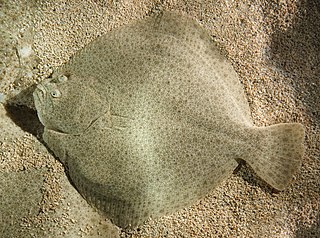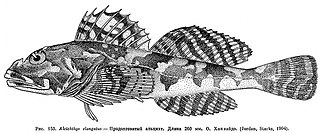
A tuna is a saltwater fish that belongs to the tribe Thunnini, a subgrouping of the Scombridae (mackerel) family. The Thunnini comprise 15 species across five genera, the sizes of which vary greatly, ranging from the bullet tuna up to the Atlantic bluefin tuna, which averages 2 m (6.6 ft) and is believed to live up to 50 years.

Mackerel is a common name applied to a number of different species of pelagic fish, mostly from the family Scombridae. They are found in both temperate and tropical seas, mostly living along the coast or offshore in the oceanic environment.

Herring are forage fish, mostly belonging to the family of Clupeidae.

Sardine and pilchard are common names for various species of small, oily forage fish in the herring family Clupeidae. The term 'sardine' was first used in English during the early 15th century; a somewhat dubious etymology says it comes from the Italian island of Sardinia, around which sardines were once supposedly abundant.

The turbot is a relatively large species of flatfish in the family Scophthalmidae. It is a demersal fish native to marine or brackish waters of the Northeast Atlantic, Baltic Sea and the Mediterranean Sea. It is an important food fish. Turbot in the Black Sea have often been included in this species, but are now generally regarded as separate, the Black Sea turbot or kalkan. True turbot are not found in the Northwest Atlantic; the "turbot" of that region, which was involved in the so-called "Turbot War" between Canada and Spain, is the Greenland halibut or Greenland turbot.

The lined catshark or banded catshark is a species of catshark, belonging to the family Scyliorhinidae. It is found in the waters off the coasts of Beira, Mozambique, to East London, and South Africa between latitudes 19°S and 31°S, from the surface to 290 m. It can grow up to 56 cm in length.

The Saldanha catshark is a species of catshark, belonging to the family Scyliorhinidae. This catshark is found from Cape Columbine to south of False Bay in South Africa, between 31 and 40°S. Its length is up to 88 cm. It is a plain, dark grey-brown, stout catshark, with moderately large eyes, a broad snout, and large pectoral fins.

Altolamprologus compressiceps is a species of fish in the family Cichlidae. It is endemic to the shallow rocky areas of Lake Tanganyika. It is not considered threatened by the IUCN.

The Hawaiian grouper, also known as the Hawaiian black grouper, Seale's grouper or Hapuʻupuʻu, is a species of marine ray-finned fish, a grouper from the subfamily Epinephelinae which is part of the family Serranidae, which also includes the anthias and sea basses. It is endemic to Hawaii.
The graceful priapella, also known by its original Spanish name guayacon ojiazul, is a species of freshwater fish within the family Poeciliidae. It is considered to be data deficient. It is endemic to a small part of central Veracruz in Mexico. It has not been recorded recently and is thought most likely to be extinct, however, the IUCN states that there is an outside chance that the species clings on in a hereto unsurveyed part of its known range and so list it as Data Deficient. The American ichthyologist Seth Eugene Meek described this fish as Gambusia bonita in 1904 with the type locality given as Río Tonto at Refugio, Veracruz, Mexico. It is the type species of the genus Priapella.

Eels are ray-finned fish belonging to the order Anguilliformes, which consists of eight suborders, 20 families, 164 genera, and about 1000 species. Eels undergo considerable development from the early larval stage to the eventual adult stage and are usually predators.

An anchovy is a small, common forage fish of the family Engraulidae. Most species are found in marine waters, but several will enter brackish water, and some in South America are restricted to fresh water.

Boops is a genus of marine ray-finned fishes belonging to the family Sparidae, the seabreams and porgies. There are two species in this genus, one in the Western Atlantic and Mediterranean, and the other in the Western Indian Ocean.

The pike topminnow, more commonly known as pike killifish and sometimes referred to as topminnow, is a species of poeciliid found from Mexico to Nicaragua. It has also been introduced to Florida, USA. It is the only known member of its genus. The pike topminnow was described in 1860 by Austrian ichthyologist Rudolf Kner, who gave the type locality as Belize, which is reflected in this species' specific name.
Bovitrigla is a monotypic genus of marine ray-finned fishes belonging to the family Triglidae, the gurnards and sea robins, one of two genera belonging to the subfamily Pterygotriglinae. Its only species, Bovitrigla acanthomoplate, is found in the western Pacific Ocean.

Alcichthys is a monospecific genus of marine ray-finned fish belonging to the family Cottidae, the "typical" sculpins. The only species in the genus is Alcichthys elongatus, which occurs in the northwestern Pacific Ocean.

Iguanodectidae is a family of freshwater fish in the order Characiformes that lives in South America. It is home to the subfamily Iguanodectinae and the monotypic Bryconops clade. Several species in the family, such as the green line lizard tetra, the tailspot tetra, and the orangefin tetra, are sometimes taken as aquarium fish.
Hadropogonichthys is a monospecific genus of marine ray-finned fish belonging to the family Zoarcidae, the eelpouts. The only species in the genus is Hadropogonichthys lindbergi which is in the northwestern Pacific Ocean.















